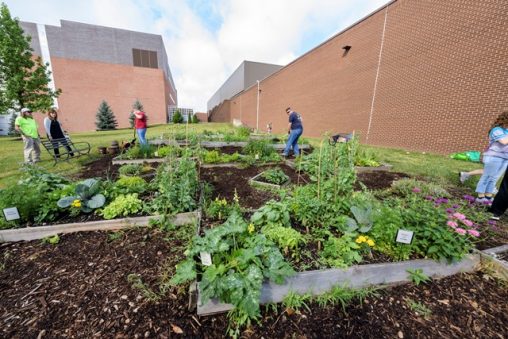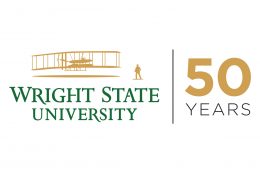For theatre, business, social work and other non-science majors, taking a college science course can sometimes be a little intimidating.
Lisa Kenyon, associate professor of biological sciences and teacher education and Distinguished Professor of Teaching at Wright State University, gets that.
So Kenyon and Michelle Fleming, associate professor in teacher education, are using a Teaching Innovation Grant to redesign one non-science major course and two education major courses.
Their project is called Gardens Restoring Our Wellness (GROW)ing a WSU STEM Community. The goal is to increase student engagement through STEM learning experiences connected to course content around health, gardening, food, community and sustainability using innovative technologies.
Included in the redesign is a student garden and 10 iPads for development of learning activities. The Center for Teaching and Learning has been integral in providing instructional design and professional development support for the planning development of the learning activities that leverage the iPads.
Computing and Telecommunications Services (CaTS) provided the infrastructure support and configured the iPads for multiuse to enable groups of students to develop both personal and group skills.
The tablets also feature an app that offers deeper answers to questions posed by the students as they master the scientific material.
“This isn’t just a lecture course with PowerPoints,” said Kenyon. “Hopefully, they can find some meaning in what they’re doing. … I want them to see that science isn’t just for scientists.”

Students in Lisa Kenyon’s Biology of Food class work in the student garden on campus. (Video by Kris Sproles/Photo by Erin Pence)
Kenyon is using the iPads in her Biology of Food class, which teaches the science of healthy food and sustainability. As part of the class, the students are involved in the Wright State student garden, which is adjacent to the Student Union and the Russ Engineering Center.
On this particular day, the students are snipping and bagging lettuce, arugula and peas. Others are using shovels to spread mulch with rainbow-like arcs.
But technology is part of the core of the class.
“We’re also having them learn to use technology like iPads in the classroom to talk about food, gardening and community,” Kenyon said.
Each iPad weighs 1.5 pounds and is equipped with a battery that lasts up to 10 hours before having to be recharged.
“It’s much easier to move around with an iPad,” Kenyon said.
Kenyon poses different explanatory questions to her class to figure out while working on the iPads.
“I’m really interested in learning how students think and reason,” she said.
In groups of three, students use an app called Explain Everything on the iPads to create diagrammatic models that explain how and why something happens, such as “How and why does food travel to my cells?”
They also do a media project in which they answer a question such as “Why should we save the bees?” or “How does gardening promote mental health?” and create a three-minute video to share with their peers.
“It’s amazing,” said Kenyon. “At first they were very hesitant and nervous, and now they are pros.”
Kenyon said she tries to tap into the different strengths of the students, who come from a wide variety of backgrounds and majors.
 “I have theatre majors in my class who really like to talk and narrate,” she said. “…They all have a different way of looking at the world.”
“I have theatre majors in my class who really like to talk and narrate,” she said. “…They all have a different way of looking at the world.”
Even students who are pursuing careers that will involve some science find value in the class.
Larry Laws, a nursing major, has used computers and a smartphone, but not an iPad to any great extent. He said the iPad’s TeachBack app helps him retain the material.
“I think I learned a lot, probably a lot faster and a lot better, with the interactive portion of the class than just sitting down and reading out of a book,” Laws said. “…I think a lot of this stuff that Dr. Kenyon put up and had us do was a lot more interactive, more hands-on and helping cement the foundation of what she was trying to teach to us.”

 Heavy metal learning
Heavy metal learning  State grants to bolster Wright State’s electric vehicle and advanced manufacturing training for students
State grants to bolster Wright State’s electric vehicle and advanced manufacturing training for students  Wright State partners with local universities, hospitals to expand mental health care for students
Wright State partners with local universities, hospitals to expand mental health care for students  Wright State students, first responders team up for Halloween event
Wright State students, first responders team up for Halloween event  Explore Wright State Day welcomes hundreds of future Raiders
Explore Wright State Day welcomes hundreds of future Raiders 